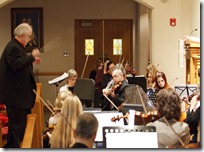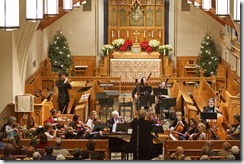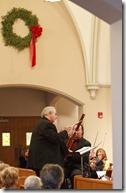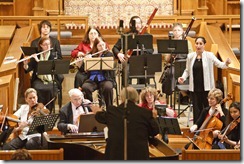WHAT’S A WASSAIL? BONJ OFFERS ONE
By Sheila Abrams
Wishing you good health for the coming year is an old English New Year tradition, and the wish is often accompanied by hot mulled cider. The tradition is called a wassail, which refers both to the event and the drink, and the word comes from Old (as in medieval) English.
The Baroque Orchestra of New Jersey, sadly, didn’t have any of that delicious drink last Sunday when they offered their wassail, but they had instead a cornucopia of wonderful music to accompany their good wishes. If joy promotes good health—and we believe it does—this event had to be therapeutic.
Like lights glancing off the facets of a crystal , the notes of Baroque music glitter. The program on Sunday, held in the sanctuary of the beautiful Grace Church in Madison, was complex and varied, with its English roots sometimes a bit of a stretch. And not all the music was Baroque. But conductor Robert Butts knows how to build a program for maximum enjoyment, and the orchestra has a dazzling array of wonderful musicians, very much in evidence.
We’d like to say here that we are impressed by the frequency with which Butts brings into the spotlight members of the orchestra as soloists, perhaps even selecting pieces because they offer an opportunity for a particular player to shine. This must be a source of pleasure to musicians who toil in the back rows of the orchestra and rarely get to show off their virtuosity. Sunday’s wassail included solo opportunities for a trumpeter, a bassoonist and two flautists, as well as a violinist, a pianist and a soprano.
 The opening piece consisted of the overture and rondeau from the Suite from Abdelazar, by 17th century Baroque master Henry Purcell. Though the name of the piece might not have rung a bell, the music did. The rondeau provided the theme for Benjamin Britten’s famous Young Person’s Guide to the Orchestra , which is subtitled “variations and fugue on a theme of Purcell.”
The opening piece consisted of the overture and rondeau from the Suite from Abdelazar, by 17th century Baroque master Henry Purcell. Though the name of the piece might not have rung a bell, the music did. The rondeau provided the theme for Benjamin Britten’s famous Young Person’s Guide to the Orchestra , which is subtitled “variations and fugue on a theme of Purcell.”
 Staying with Purcell, the orchestra then teamed with a soloist, Michael Bassett (at left in photo to right) on the trumpet. In the Sonata for Trumpet and Strings, a cascade of rapid notes showered the audience with a uniquely Baroque glitter. At 19, Bassett shows a remarkably mature composure to accompany his youthful energy. The piece was performed on a piccolo trumpet, a smaller, higher pitched instrument suited to the fast pace of Baroque music. (above right: The Baroque Orchestra of New Jersey with trumpeter Michael Bassett performing Handel's "Water Suite")
Staying with Purcell, the orchestra then teamed with a soloist, Michael Bassett (at left in photo to right) on the trumpet. In the Sonata for Trumpet and Strings, a cascade of rapid notes showered the audience with a uniquely Baroque glitter. At 19, Bassett shows a remarkably mature composure to accompany his youthful energy. The piece was performed on a piccolo trumpet, a smaller, higher pitched instrument suited to the fast pace of Baroque music. (above right: The Baroque Orchestra of New Jersey with trumpeter Michael Bassett performing Handel's "Water Suite")
 One of the high points of the concert was the premiere of a piece written by Butts as a birthday gift for one of the orchestra’s two bassoonists, Andrew Pecota. Entitled Two Songs for Bassoon and Strings, it is a lovely work, more lyrical than most 21st century compositions. The first song featured the bassoon’s melody set like a velvet ribbon against a pizzicato background from the violins. The second song is, simply told, an exquisitely romantic melody. What a birthday gift! A treasure for the giver and the recipient, as well as any audience who gets to hear it. (left: Dr. Robert W. Butts conducts and Andrew Pecota plays bassoon at the world premiere of "Two Songs For Bassoon and Strings" composed by Dr. Butts.)
One of the high points of the concert was the premiere of a piece written by Butts as a birthday gift for one of the orchestra’s two bassoonists, Andrew Pecota. Entitled Two Songs for Bassoon and Strings, it is a lovely work, more lyrical than most 21st century compositions. The first song featured the bassoon’s melody set like a velvet ribbon against a pizzicato background from the violins. The second song is, simply told, an exquisitely romantic melody. What a birthday gift! A treasure for the giver and the recipient, as well as any audience who gets to hear it. (left: Dr. Robert W. Butts conducts and Andrew Pecota plays bassoon at the world premiere of "Two Songs For Bassoon and Strings" composed by Dr. Butts.)
 Soprano Valerie Muller (right) offered two pieces: Rejoice Greatly, from Handel’s The Messiah, and the aria In Uomini, from Mozart’s opera, Cosi Fan Tutte. Mozart may not have been a Baroque composer, nor was he English. He did, however, spend some time in England and was there befriended by Johann Christian Bach, Johann Sebastian’s youngest son and the one sometimes called “the Englsh Bach.” We also tend to feel, as Butts apparently does, that a little Mozart never hurts.
Soprano Valerie Muller (right) offered two pieces: Rejoice Greatly, from Handel’s The Messiah, and the aria In Uomini, from Mozart’s opera, Cosi Fan Tutte. Mozart may not have been a Baroque composer, nor was he English. He did, however, spend some time in England and was there befriended by Johann Christian Bach, Johann Sebastian’s youngest son and the one sometimes called “the Englsh Bach.” We also tend to feel, as Butts apparently does, that a little Mozart never hurts.
The aforementioned J.C. Bach was also represented by a beautiful performance of his Quartetto, featuring the orchestra’s wonderful flautists, Margaret Walker and Catherine Barlow Garrison, joined by first violinist Agnes Kwasniewska.
The glittering Baroque trumpet, once more in the hands of Michael Bassett, returned for a performance of Handel’s Water Piece Suite, a short version of the familiar Water Music, consisting of an overture and four absolutely delightful dance pieces.
The concert concluded with a return to Mozart. If, as we said, a little Mozart never hurts, in this case, a little more will leave a happy audience. The Piano Concerto No. 5 was played by John Pivarnik and the orchestra. It was composed by the 17-year-old Mozart in 1773 and was his first completely original piano concerto, not based on themes from other composers. It was reportedly a personal favorite of the composer, who delighted in playing it himself.
A Madison resident who is also an organist and choirmaster, Pivarnik gave the work a precise and joyful performance.
The wassail happened to fall on the Multicultural Music Day, part of Listen For Life, and was selected to be one of eight musical events around the world to be included. For more information on that, go to www.listenforlife.org.